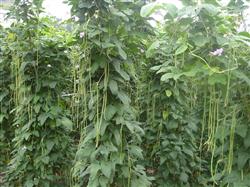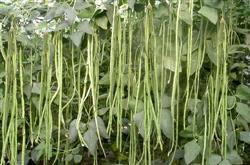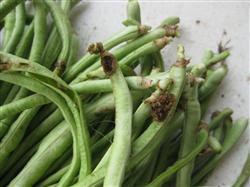How to prevent and cure rust by planting beans in autumn?

How to prevent and cure rust by planting beans in autumn? Please introduce the prevention and control methods of planting beans in autumn with high temperature and more rainfall, coupled with the large bacterial source (summer spores) of beans planted in spring in the field. Therefore, beans planted in autumn are prone to rust, and farmers should carry out comprehensive control as soon as possible. 1. Main symptoms: beans can be infected with bacteria throughout the growing period, but the resistance weakens and the susceptibility increases during the period from the beginning of flowering to fruiting. The disease mainly affected the leaves, and in the early stage of the disease, there were little faded yellow and white spots under the leaves, and the spots gradually increased until the whole leaf was densely covered. The yellow-brown slightly raised scab spots were formed on the back of the disease spot, that is, the summer spore pile. After the rupture of the summer spore pile, a large number of summer spores were scattered, and sometimes a black winter spore pile was formed on the old leaves in the late growth stage. The leaves are withered and yellow, the plants are short, the pods are few and small, the growth period is shortened, and finally wither and die. Second, the pathogen is basidiomycete subphylum, unicellular rust genus. The source of infection is the diseased remains of spring-planted beans or the heap of summer spores left in the field. The summer spores germinate to produce germ tubes and invade the host with stomata. At 18Mel 25 ℃, when the air humidity was high or the fog was heavy, when there was a water dripping film on the host surface, the summer spores germinated most easily and invaded the host, and the diseased plants spread through air currents, insects, humans and animals, causing frequent re-infection, and the resulting winter spore pile became the primary infection source of legume crops planted in the following spring. Third, prevention and control methods: comprehensive control measures based on strengthening the management of soil fertilizer and water, supplemented by timely spraying. The main results are as follows: 1. Remove the diseased body and reduce the source of infection: after spring planting beans are harvested, the dead seedlings of residual plants are collected and burned to reduce the source of infection. 2. Seed selection and site selection: ① selection and planting: disease-resistant varieties, such as Suifeng 8 and Zaofeng 3, should be planted in double rows or single rows, which is easy to eliminate stagnant water and dredge air, which is not conducive to the landing and invasion of summer spores. ② site selection: it is best to choose the previous crop as the field of Gramineae, not the previous crop as the field of legume or peanut. In this way, it can avoid the direct attack of rust. 3. Rational fertilization: applying sufficient base fertilizer, early topdressing and increasing phosphorus and potassium fertilizer can enhance the activity of root nodules, sturdy plant growth, thick green leaves and enhanced disease resistance. 4. Timely application of pesticide for prevention and treatment: timely application of pesticide at the initial stage of the disease. The medicament can be sprayed with 50% trimethoprim 600 Mel 800 times or 50% sulfur suspending agent 500 Mel 600 times or 70% methyl topiramate 800 Mel 1000 times. Spray every 8 Mel every 10 days and spray 2 Mel 3 times in a row. Click to get more bean planting techniques click to get more vegetable planting techniques
- Prev

How can you grow beans in autumn with high yield?
How can you grow beans in autumn with high yield? Please introduce the planting method for planting beans in autumn can refer to the following methods: first, variety and soil selection. Bean varieties with strong cold and humidity resistance and strong flowering ability should be selected for planting beans in autumn. The soil should choose higher topography, deep soil layer, good drainage,.
- Next

How to control heart worms by planting beans?
How to control heart worms by planting beans? Please introduce the prevention and control of planting bean borer, spray should adhere to the principle of bud control, spray and kill the larvae in the flower bud during flowering. The best time to spray is when the bud is open from 8 am to 10:00 on a sunny day. Spraying the pod more than 10 cm long after flowering can kill the newly hatched larvae.
Related
- Where is it suitable to grow horseradish in China? it is expected to see the middle altitude horseradish in Alishan.
- How to prevent tomato virus disease reasonably? (Control methods included)
- Many people like to plant towel gourd on the balcony. What are the main points of this method and management?
- What crops can chili peppers be mixed with?
- Fertilization techniques and matters needing attention in Tomato
- What are the grafting techniques for peach seedlings in spring?
- Harm and control methods of root swelling disease of Chinese cabbage
- What are the pests of sweet potatoes? How to prevent and cure it?
- Symptoms, causes and Control methods of navel Rot in Tomato
- The cause of "Cucumber rotten bibcock" in Farmers' planting Cucumber and its Control Plan

